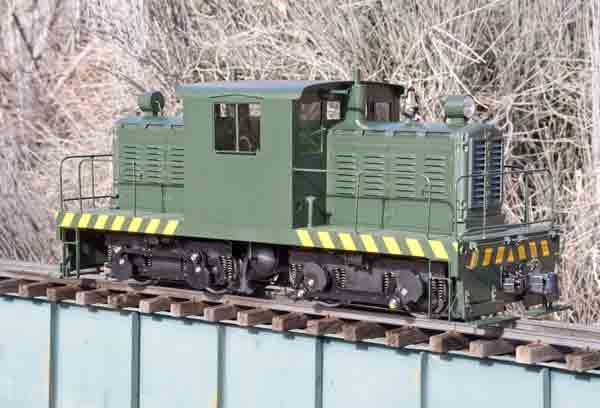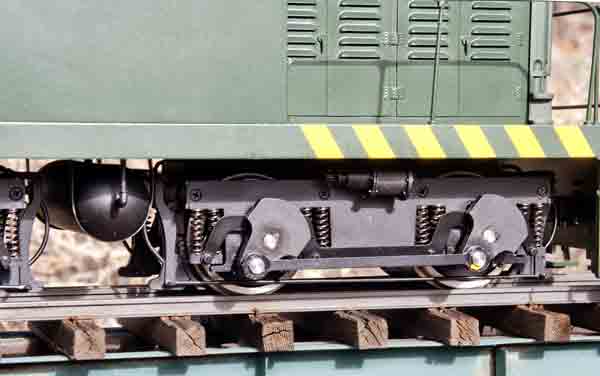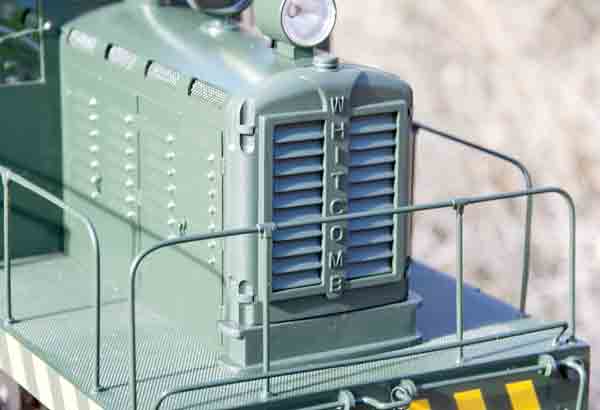Accucraft Trains
33268 Central Ave.
Union City CA 94587
Price: $995
Website: http://accucraft.com
1:20.3 scale, gauge-1 model of 45-ton Whitcomb side-rod, diesel-electric locomotive; track powered; all metal construction; 0-24V DC operation; LED directional lighting; working knuckle couplers; two motors; all wheels powered. Dimensions: Length over end beams, 15″; width, 5 3/8″; height, 6½”. In 1:20.3 scale, this works out to 25′ 4½” x 9’1″ x 11’0″, respectively. Weight, 10 pounds
Pros: Finely crafted, well-detailed model; accurate representation of prototype; correct scale/gauge combination; will negotiate very tight curves; excellent paint and graphics; good flange profile; excellent performance characteristics; powerful hauler
Cons: Heavy locomotive; no provision made for upgrading to DCC or sound; difficult motor and body access, inadequate instruction sheet
The model is constructed of brass and stainless steel. It is well detailed and closely matches the photos of the prototype I was able to find, down to the vertically lettered “whitcomb” in the center of the grill on either end. All windows are glazed, revealing full cab interior. Our review sample came painted dark green with yellow safety stripes and no lettering. The engine is also available in gray, blue, or yellow paint.
The diesel-electric prototype had two traction motors, each geared to one axle of each truck. The other axles were powered by the side rods, giving the engine a distinctive appearance. Accucraft’s track-powered model likewise has two motors, each powering one axle. The trucks swivel freely and have a great deal of rotation, allowing the engine to traverse the tightest of curves.
The instruction manual says to oil the motor bearings periodically. However, I found motor access to be impossible without almost entirely disassembling the truck. The instructions do not address this point. To remove the body, the instructions say to remove the hex bolts from underneath. However, which hex bolts to remove are not specified and there are lots of them. I ended up unnecessarily unscrewing some of the cab interior. Much grief could have been avoided with adequate instructions.
Electrically, the engine is quite simple. All wheels provide pickup points. Inside the body are no electronics. Power goes to the lights and motors only. There is an unidentified switch on the bottom of the engine (no mention in the instructions, nor does appear in the wiring diagram). I was later able to determine that this cuts out the motors, leaving the lights working. If you were to add electronic features to this locomotive, all components would have to go beneath the hoods because of the cab interior.
Performance characteristics are good. The directional lights, which are LEDs, come on as the engine begins to move, at around 4V. Slow-speed operation is excellent, with the engine just creeping along. Top speed, at 24V, is pretty brisk—probably faster than the prototype was capable of. Control throughout the speed range is quite good. The engine is smooth and quiet in operation. At full speed, the engine draws a little over 2 amps. At full slip, it draws around 6 amps. Tractive effort of this locomotive is two pounds and 12 ounces, or the equivalent of around 35 average freight cars on straight, level track, which is very good indeed.
This is an unusual and well-made engine. It runs well and will pull a substantial load. If your narrow-gauge line is in the market for a new diesel, this is definitely one to look at.
















